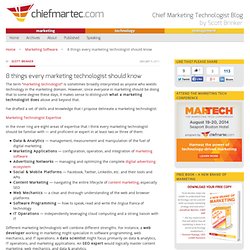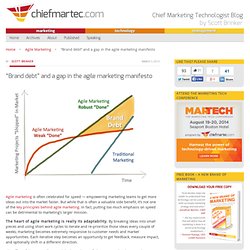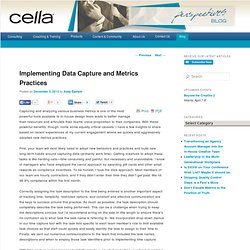

Leading Professional Association For In-House Agencies. 8 things every marketing technologist should know. The term “marketing technologist” is sometimes broadly interpreted as anyone who wields technology in the marketing domain.

However, since everyone in marketing should be doing that to some degree these days, it makes sense to distinguish what a marketing technologist does above and beyond that. Rise of the Marketing Technologist. Last week, I gave my talk at Search Insider Summit on the Rise of the Marketing Technologist.

Based on the positive feedback I received from brands, agencies, and technology vendors alike, it apparently resonated deeply. So, first, I’d like to share the slide presentation with you: However, since slides can’t capture the full dynamics of the presentation, I thought I would follow with an essay version of my talk as well. My premise is simple: marketing must control its technological destiny. In the past few years, marketing has been flooded with a deluge of marketing technologies. And more innovations are pouring in every day. The migration of money from old media to new mediacloud computing and the migration from IT to SaaSthe measurable nature of digital to demonstrate ROIa greenfield of opportunity for new entrantsthe high-velocity economics of software innovation. Agile marketing for a world of constant change. [UPDATE: I've also posted a video recording of this agile marketing presentation that I gave at the Marketo User Summit in April 2013.]

Today I’m giving a presentation at the Marketing Operations Executive Summit on agile marketing. Given the tremendous disruption in marketing and business today, I truly believe that embracing an agile approach to marketing management may be the single most valuable decision an organization can make. "Brand debt" and a gap in the agile marketing manifesto. Agile marketing is often celebrated for speed — empowering marketing teams to get more ideas out into the market faster.

But while that is often a valuable side benefit, it’s not one of the key principles behind agile marketing. In fact, putting too much emphasis on speed can be detrimental to marketing’s larger mission. The heart of agile marketing is really its adaptability. By breaking ideas into small pieces and using short work cycles to iterate and re-prioritize those ideas every couple of weeks, marketing becomes extremely responsive to customer needs and market opportunities. Each iterative step becomes an opportunity to get feedback, measure impact, and optionally shift in a different direction. The effect of this is usually a much higher velocity of ideas into market, because the scope of iterations are kept as small as possible while still being meaningful.
But that caveat about iterations “still being meaningful” is important. A little brand debt isn’t the end of the world. 6 Ways Tech Will Change Education Forever. Tensions were high Wednesday at New York University's Stern School of Business, as a group of academics, venture capitalists, and entrepreneurs faced off during a panel discussion on the future of higher education.

The panelists, including NYU President John Sexton, Harvard Business School professor Clayton Christensen, and Codecademy CEO Zach Sims, among others, were charged with predicting the future of the traditional university. Will emerging technology and online learning dismantle the notion of "college" as we know it? Predictably, the academics took a markedly more conservative view than their start-up counterparts, but there was one thing everyone in the room could agree on. As Sexton put it, "The status quo is not an option. We're in for what I call a radical restructuring of higher education today.
" Here are six big ideas about how tech incumbents are about to drastically change the face of education: 1. 2. 3. Tips and Tools for Building a Marketing Team. A perfect storm for marketing technology. To say that there are a lot of marketing technology companies out there is a major understatement.

To help picture the scale of this expanding universe, here’s just a sample of the players in the field: These are merely a fraction of the firms offering marketing automation, web analytics, campaign management, conversion optimization, email marketing, bid management, keyword research, attribution management, behavioral targeting, digital asset management, marketing resource management, social media monitoring — and I’ve left out numerous categories.
And more are on the way. It makes you appreciate the spectacular sea change that is occurring in marketing. The forces that are driving this Renaissance of innovation and entrepreneurship in marketing technology are the same forces upheaving individual marketing departments and agencies. 1. 2. 3. 4. 5. Implementing Data Capture and Metrics Practices. Capturing and analyzing various business metrics is one of the most powerful tools available to in-house design team leads to better manage their resources and articulate their teams’ value proposition to their companies.

With these powerful benefits, though, come some equally critical caveats. I have a few insights to share based on recent experiences at my current engagement where we quickly and aggressively adopted new metrics practices. First, your team will most likely need to adopt new behaviors and practices and build new long-term habits around capturing data (primarily work time).
Getting creatives to adopt these tasks is like herding cats—time consuming and painful, but necessary and unavoidable. I know of managers who have employed the carrot approach by awarding gift cards and other small rewards as compliance incentives. Correctly assigning the task description to the time being entered is another important aspect of tracking time.